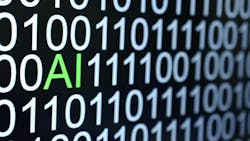Human intelligence plus AI and how supply chains are changing with this collaboration
What you'll learn:
- This partnership of human and artificial intelligence is redefining how organizations plan, buy, make, move, and fulfill.
- Most organizations struggle not from a lack of data but with fragmentation, complexity, and the ability to turn information into clear action.
- The most successful transformations over the past year have come from organizations that treat AI as an accelerator of human decision-making, not a replacement for it.
Across industries, supply chains are being reshaped by a new equation that combines human intelligence and artificial intelligence to unlock speed, scale, and resilience.
AI systems accelerate analytics, automate data processing, and surface insights at unprecedented scale. Human expertise brings context, creativity, and judgment to turn those insights into measurable results.
See also: Major robotics companies use NVIDIA technology to develop automated systems
This partnership of human and artificial intelligence is redefining how organizations plan, buy, make, move, and fulfill. The future of operational excellence depends not on technology alone but on how effectively people and AI collaborate to make smarter decisions faster.
Most organizations do not suffer from a lack of data. They struggle with fragmentation, complexity, and the ability to turn information into clear action.
Modern AI systems can analyze millions of records across procurement, logistics, and operations in seconds, but even the most advanced algorithms cannot fully grasp the strategic tradeoffs that drive business success.
At my company, Maine Pointe, this balance is achieved through what we call combined intelligence, the fusion of AI-driven analytics with practitioner expertise. This approach ensures that machine insights are validated by human experience, transforming data transparency into business transformation.
The human and AI impact
The most successful transformations over the past year have come from organizations that treat AI as an accelerator of human decision-making, not a replacement for it. The pattern is clear: Companies achieve the fastest and most sustainable results when they combine AI’s analytical power with the judgment and creativity of experienced operators.
Q&A: How analytics, AI, digital twins help manufacturers build resilient supply chains
Consider a global food service buying group that faced growing complexity in supplier negotiations and invoice management. Using advanced AI analytics, the team processed more than 350,000 line items in just weeks.
Human category managers then applied context to identify patterns in pricing and volume, reshaping vendor agreements and capturing more than three million dollars in annualized savings.
By combining data-driven insight with negotiation expertise, the organization improved EBITDA by 20% and reduced administrative workload by hundreds of hours each week.
While investment in AI continues to rise, most companies have yet to realize meaningful returns. Recent research shows that only a small group of organizations capture the majority of the value being created.
In distribution and logistics, a national wholesale distributor used AI-powered optimization to redesign its network and rebalance inventory across multiple regions.
The algorithms modeled thousands of routing scenarios and warehouse configurations, but it was the logistics planners who chose which strategies were practical and aligned with customer priorities.
See also: Data quality issues costing manufacturers billions, survey says
That collaboration unlocked fifty-four million dollars in measurable benefits, including significant profit improvement and a twenty percent gain in workforce efficiency.
A specialty chemicals manufacturer achieved similar gains by integrating AI forecasting with its sales and operations planning process. AI predicted regional demand fluctuations and production constraints.
Human planners validated those insights, accounting for real-world factors such as maintenance schedules, supplier relationships, and seasonal disruptions. The result was improved capacity utilization, shorter lead times, and stronger service reliability.
And in industrial operations, a manufacturer used digital twins and machine learning to simulate production performance in real time.
AI surfaced potential process bottlenecks and labor inefficiencies, while operators fine-tuned the scenarios and implemented workflow changes that reduced downtime and improved output quality.
Modern AI systems can analyze millions of records across procurement, logistics, and operations in seconds, but even the most advanced algorithms cannot fully grasp the strategic tradeoffs that drive business success.
These examples highlight a fundamental truth: AI brings speed, scale, and visibility, but it is human intelligence that ensures those capabilities are applied with purpose and precision.
The companies realizing measurable gains are those that have found the right balance between data science and domain expertise. AI extends what people can see, while people decide what to do with that insight.
Bridging the AI adoption gap
While investment in AI continues to rise, most companies have yet to realize meaningful returns. Recent research shows that only a small group of organizations capture the majority of the value being created. The reasons are rarely technical. Most challenges come from people and processes rather than from algorithms or infrastructure.
See also: Agentic AI’s utility in process manufacturing
Common barriers include a lack of leadership alignment, unclear ROI cases, resistance to change, and poor data quality. To overcome these obstacles, executives should focus on four foundational priorities:
- Leadership alignment: Create clear executive sponsorship and demonstrate how AI supports business strategy.
- Data quality: Standardize and clean data to give AI systems reliable input for decision-making.
- Upskilling the workforce: Build AI literacy so employees view technology as a collaborator, not a competitor.
- Scalable implementation: Start small to prove value, then expand with repeatable, cross-functional frameworks.
These steps ensure that AI adoption stays aligned with human capability and organizational goals.
Toward self-optimizing supply chains
The next evolution will be intelligent systems that not only analyze and recommend but also take guided actions within parameters set by humans. When integrated with digital twins, these systems can simulate disruptions, test scenarios, and adapt to real-world changes in real time.
Podcast: How exploitable gaps in popular networking devices show how far OT cybersecurity still has to go
This level of intelligence brings new opportunities for resilience, but it does not replace the need for human oversight. The most advanced supply chains of the future will be self-optimizing ecosystems guided by ethical, creative, and strategic human leadership.
A practical playbook for executives
Execs seeking to integrate AI effectively should begin with alignment and culture, not just technology.
- Start with strategy: Identify where AI can accelerate measurable value creation such as improving working capital or increasing visibility.
- Integrate into workflows: Embed AI tools into daily decision-making so teams act on insights continuously.
- Measure business outcomes: Evaluate success through operational and financial metrics such as cost reduction, service improvement, and resilience.
- Balance innovation with governance: Maintain clear oversight for privacy, accuracy, and ethical compliance to preserve trust.
AI cannot replace human creativity, intuition, or empathy. What it can do is elevate performance by providing speed and precision that expand the scope of human decision-making.
See also: Sensing a shift: Trends in smart industrial automation
Organizations that learn to balance both will outperform their peers. The winners will not be those with the largest technology budgets, but those with the strongest collaboration between people and intelligent systems.
The future of supply chain management will not be automated. It will be amplified, powered by the combined intelligence of humans and AI working together to build smarter, faster, and more resilient operations.
About the Author

Nathanael Powrie
Nathanael Powrie is senior director, knowledge management and data analytics at Maine Pointe, a global supply chain and operations consulting firm. He has over a decade of experience across food and beverage, industrial, chemical, and logistics sectors and he oversees Maine Pointe’s combined intelligence solutions, unifying data, analytics, and knowledge into actionable insights across procurement, logistics, and operations.
